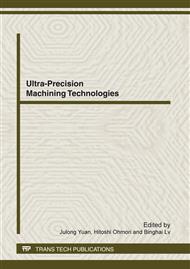p.225
p.230
p.235
p.240
p.245
p.250
p.256
p.264
p.268
Application of Orthogonal Test in Numerical Simulation of Glass Lens Molding
Abstract:
Glass lens molding is a high-volume fabrication method for producing optical components. In this paper, combined with the orthogonal test method and finite element method (FEM) simulation, the coupled thermo-mechanical analysis was carried out to analyze the key process factors. In order to reduce the testing time, an orthogonal test with three sets of level factors and three parameters is conducted to obtain the optimal molding process parameters. The result shows that the most significant parameter is molding velocity, the other effect parameters are molding temperature and friction coefficient. According to the previous analysis of orthogonal experiment, it is shown that the best optimal finishing process parameters were A2B1C1.
Info:
Periodical:
Pages:
245-249
Citation:
Online since:
April 2012
Authors:
Price:
Сopyright:
© 2012 Trans Tech Publications Ltd. All Rights Reserved
Share:
Citation:


